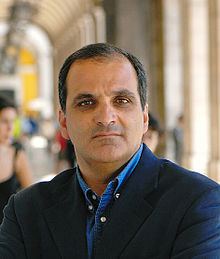 | ||
Books Beyond Baixa: signs of urban planning in eighteenth century Lisbon People also search for Margarida Calafate Ribeiro, José Mattoso, Alice Caldeira Cabral Santiago Faria | ||
Walter rossa ferreira da silva associate professor at the university of coimbra
Walter Rossa (Caracas, 1962).
Contents
- Walter rossa ferreira da silva associate professor at the university of coimbra
- Desvios e rui dos no genoma das cidades walter rossa at tedxcoimbra
- Training and career track
- Academic track
- Relevant publications
- References
Desvios e rui dos no genoma das cidades walter rossa at tedxcoimbra
Training and career track
Graduate in Architecture by the Technical University of Lisbon (1985), Master in History of Art by the Universidade Nova de Lisboa (1991), PhD (2001) and Aggregate in Architecture (2013) by the University of Coimbra. Full Professor at the Departamento de Arquitectura da Faculdade de Ciências e Tecnologia da Universidade de Coimbra (1989), and researcher at the Centro de Estudos Sociais da Universidade de Coimbra (2007). He has been visiting professor at Federal University of Bahia, Fluminense Federal University, Pablo de Olavide University, Instituto Universitário de Artes, Tecnologia e Cultura do Mindelo, University of Porto and University of the Algarve, in the last as Odebrecht Capistrano de Abreu Professor. He is, with Margarida Calafate Ribeiro, coordinator of the PhD programme Heritages of Portuguese Influence.
Academic track
He has published works on history and theory of urbanism, history of architecture and cultural heritage in Portuguese, English, Spanish French and Italian. His research has been developed following two main tracks:
I. One dedicated to land ordinance, urban planning and urbanism of Portuguese Influence, which main milestones are:
- His master's degree thesis published in Portuguese and English (1998): Beyond Baixa: signs of urban planning in eighteenth century;
- The book chapter A cidade portuguesa (1995), published at the História da Arte Portuguesa directed by Paulo Pereira;
- The bilingual book Indo-Portuguese Cities: a contribution to the study of Portuguese urbanism in the Western Hindustan (1997);
- The consolidation of that research track has been reached in 2002 with the book A urbe e o traço: uma década de estudos sobre o urbanismo português gathering his most relevant papers produced from 1989 to 2001;
- The research project Bombay Before the British: the Indo-portuguese layer. (2004-2007), held under his coordination, is another milestone.
During the last years his work evolved through the reading of Iberian urbanism cultures as a whole, with respect to the transfer of the main European urbanizing procedures and models on the configuration of colonial cities and territories. The first synthesis comes out as the keynote lecture Stone Raft: allegory on the spread of European urbanistics in Early Modern times, addressed to the 12th International Conference on Urban History: Cities in Europe Cities in the World (2014), held by the European Association for Urban History (EUHA).
II. The second research track is about urban planning for relevant cultural heritage contexts. Although during the first years his work was primarily focus on planning and project experiences, it became gradually more and more centred on theoretical discussion. Among those experiences are:
- The proposal for the Conservation Project of S. Salvador of Grijó Competition (2002). 1st Prize-winner;
- The proposal for the Conservation Plan for Rua da Sofia (Coimbra) Ideas Competition (2003). 3rd Prize-winner;
- The proposal for the Project of the Coa Valley Museum Competition (2004). 3rd Prize-winner;
- The coordination of the Pombaline Nucleus of Vila Real de Santo António Conservation Plan (2003-2005), and the rebuilding project for its Casa da Câmara e Cadeia City Council Building (2006-2009).
These plans and projects have been published, including its theoretical support and discussion. Other texts addressing the conceptualization of cultural urban heritage and safeguard and/ or conservation planning, are gathered in the book Fomos condenados à cidade: uma década de estudos sobre património urbanístico recently published.
III. During the last years the finding of synergies between that two research tracks lead him and his research team to the formulation, testing and development of concepts like grammar and urbanistic heritage, drawing history, hyperdraw and heritage as technology, leading his urbanistic analysis work to be made under the trinomial guidance of structure, form and image. His last work on that is the book chapter «Urbanismo ou o discurso da cidade». In Patrimónios de Influência Portuguesa: modos de olhar. Coimbra, Lisboa e Niterói: Imprensa da Universidade de Coimbra, Fundação Calouste Gulbenkian, Editora da Universidade Federal Fluminense, 2015.
Walter Rossa’s academic track includes a set of research projects and other activities, from which are especially relevant:
He has a large pedagogical experience. Beyond a large and diverse teaching practice he has supervised 70 theses (12 PhDs). The PhD programme Patrimónios de Influência Portuguesa (Heritages of Portuguese Influence) that he coordinates at the University of Coimbra is, since 2014, co-titled by the University of Bologna, Fluminense Federal University, Eduardo Mondlane University, Paris West University and University of the Algarve. That comes out from an internationalization project to which has been awarded the prize Projetos Inovadores no Domínio Educativo (Education Innovative Projects) granted by Calouste Gulbenkian Foundation, not only because of its formative component, but also due to its purpose to raise up an international think thank on the Portuguese influence heritages subject.
Walter Rossa is seldom requested to consulting on heritage subjects, to scientific committees and to make conferences in many countries (Brazil, Cabo Verde, China, France, India, Italy, Macao, Mexico, Mozambique, Nederland, Portugal, Singapore, South Africa, Spain, Taiwan, USA and Uruguay).
Relevant publications
Author and co-author:
Editor and co-author:
